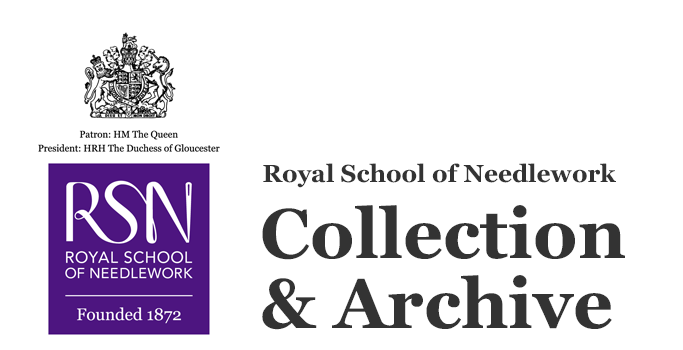Fragment
Object name
Date made
16th century
Place made
Description
A skull made in 16th-century Spain, taken from a larger item like a dalmatic or an apparel.
Content description
Fragment of embroidery depicting a skull worked in burden stitch with couched twisted passing thread outlining the eye sockets, nasal cavity, temporal bones, and teeth. Additional lines worked in back stitch feature near the eyes and the skull's top. Areas of wear show that the burden stitches have been worked over passing threads.
The skull is brown but with naturalistic shading to give a three-dimensional appearance, while the three teeth are white. The skull is probably worked on linen in silk and metal threads. It is housed in the Grove Book. Georgina Grove, who collected the textiles within the book, tacked the skull down with white thread and wrote a description below it which reads, 'Spanish, 15th or 16th Cent'. It is likely from the 16th century, cut out of a vestment or ecclesiastical embroidery used for requiem mass.
During the Counter-Reformation, which began in the 16th century, the Catholic Church encouraged the revitalisation of the arts and their role in creating intense emotions in the viewer. A variety of media were employed to produce awe amongst churchgoers. Skulls and crossbones served as momento moris, reminding congregations of the temporary nature of life. They appeared on gravestones, funerary monuments, paintings, and textiles.
In Spain, the country at the forefront of the Counter-Reformation, each church probably had a set of embroideries featuring skulls and crossbones. Many such examples, especially dalmatics and apparels, survive. Some of these momentori mori embroideries were elaborate, made for monasteries, cathedrals, or the private churches of the elite, while others were made for ordinary parish churches. Such embroideries were made by professional needleworkers in workshops, skilled nuns in convents, or lay needlewomen in the home.
This skull is housed within the Grove Book, a collection of textile pieces gathered by Georgina Grove while she travelled around Europe and India with her husband, Brigadier General Edward Aickin William Stewart Grove husband, in the late 19th century. The Grove Book was given to the RSN upon Georgina's death in 1924.
The skull is brown but with naturalistic shading to give a three-dimensional appearance, while the three teeth are white. The skull is probably worked on linen in silk and metal threads. It is housed in the Grove Book. Georgina Grove, who collected the textiles within the book, tacked the skull down with white thread and wrote a description below it which reads, 'Spanish, 15th or 16th Cent'. It is likely from the 16th century, cut out of a vestment or ecclesiastical embroidery used for requiem mass.
During the Counter-Reformation, which began in the 16th century, the Catholic Church encouraged the revitalisation of the arts and their role in creating intense emotions in the viewer. A variety of media were employed to produce awe amongst churchgoers. Skulls and crossbones served as momento moris, reminding congregations of the temporary nature of life. They appeared on gravestones, funerary monuments, paintings, and textiles.
In Spain, the country at the forefront of the Counter-Reformation, each church probably had a set of embroideries featuring skulls and crossbones. Many such examples, especially dalmatics and apparels, survive. Some of these momentori mori embroideries were elaborate, made for monasteries, cathedrals, or the private churches of the elite, while others were made for ordinary parish churches. Such embroideries were made by professional needleworkers in workshops, skilled nuns in convents, or lay needlewomen in the home.
This skull is housed within the Grove Book, a collection of textile pieces gathered by Georgina Grove while she travelled around Europe and India with her husband, Brigadier General Edward Aickin William Stewart Grove husband, in the late 19th century. The Grove Book was given to the RSN upon Georgina's death in 1924.
Dimensions
width: 9cm
height: 9.5cm
height: 9.5cm
Materials
Stitches
Motifs
Catalogue number
COL.1924.20.Grove.3
© Royal School of Needlework

